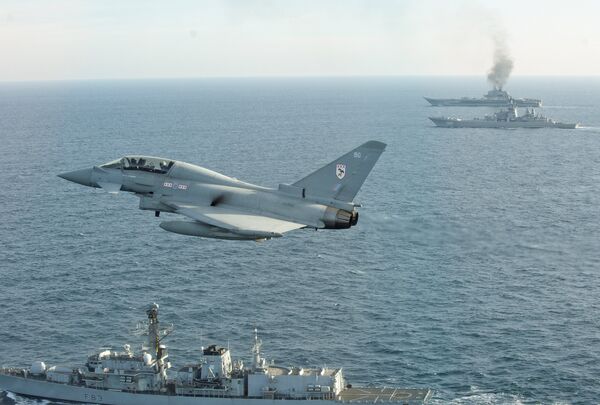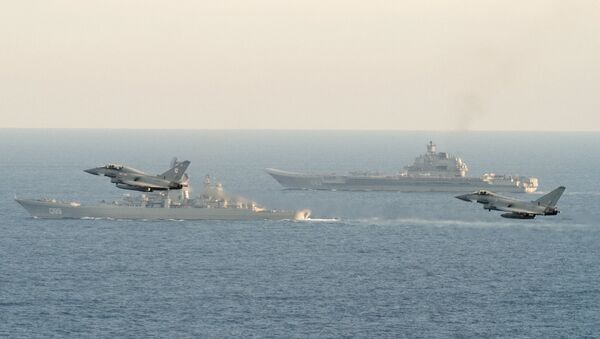On Tuesday, Sergey Artamonov, the commander of the Russian aircraft carrier Admiral Kuznetsov, which has recently returned from Syria to its home port in the northern city of Severomorsk, revealed that the cruiser was followed by 50-60 NATO ships on its journey to Syria and back.
"During the trip, we detected the presence of 50-60 NATO ships close to us. In some places, we were followed by 10-11 [NATO ships] simultaneously," Artamonov said in an interview with the Russian newspaper Argumenty i Fakty.

"The escort turned out to be hefty and expensive…for the taxpaying member states of the alliance," Radio Sputnik contributor Ilya Kharlamov noted in his article.
"Moscow has repeatedly warned Brussels (the headquarters of the alliance) that the Russian naval group, which was led by the Admiral Kuznetsov and included the battle cruiser Pyotr Veliky, the guided missile destroyer Severomorsk and the anti-submarine destroyer Admiral Kulakov as well as support vessels, doesn’t need senseless 'escort services'. It will arrive at the deployment site and leave it when it deems necessary. They don't get humor in NATO headquarters and did things their own way. They simply have no sense of humor there," the article contintinues.
The author hypothesizes that the military officials of the alliance may be split into two clans: those who benefit from the illusory notion of a "Russian threat", and those who consider it an article of faith and childishly believe in it.
"Indeed, they spare no expense on tilting at windmills, in other words, fighting with their own shadows, phobias and hallucinations," the author says.
Their numerous Middle Eastern and African forays have brought no use to mankind, including its "most enlightened" Western part, Kharlamov says. Their partial control over certain hydrocarbon deposits could not be called a global success.
Filling countries bordering Russia with NATO servicemen and equipment is also a "double-edged weapon," he adds. On the one hand, it is a demonstration of force and stimulation of the so-called "patriotically-anti-Russian" upsurge. However on the other, it entails high expenses and the absolute pointlessness of NATO's tanks, aircraft and servicemen in the event of a large-scale conflict.
"However large amounts of high-tech, extremely pricy but nonetheless highly breakable hardware require exercise, preferably in a way which will allow some showing off," the author says.
"Any military block needs dynamics and development; otherwise its mere existence comes into question. In the absence of natural conditions, such dynamics could be caused artificially. And the mission of the Russian naval group to Syria's shores provides a very fitting occasion," he explains.
Kharlamov also commented on earlier mainstream media reports that the Admiral Kuznetsov had been "billowing clouds of black smoke" and Artamonov remarks on the issue.
The aircraft carrier's fume is not an indication of any malfunctioning, the commander of the Admiral Kuznetsov explained. NATO ships in fact also "billow clouds of smoke", albeit probably not as high as the Russian cruiser; it has the highest smoke pipe. The only vessels which do not exhaust fume are those with nuclear power generating facilities, however Admiral Kuznetsov isn't that type, he said.
"It turns out that NATO ships also billowing clouds of black smoke," Kharlamov writes.
"Moreover, despite billions and billions spent on their development and production, they behave very unreliably, breaking down and leaking water into the engine decks," he adds.
"However, NATO destroyers, corvettes and frigates look ultramodern and at times alien. Apparently in order to visually terrify their enemies in the event when their strike systems fail," Kharlamov notes.
"Meanwhile, the "ageing" Russian vessel has completed its mission by successfully redeploying into another part of the globe and returning to its home port. Not everything is gold that glitters," he concluded.
Never miss a story again — sign up to our Telegram channel and we'll keep you up to speed!




